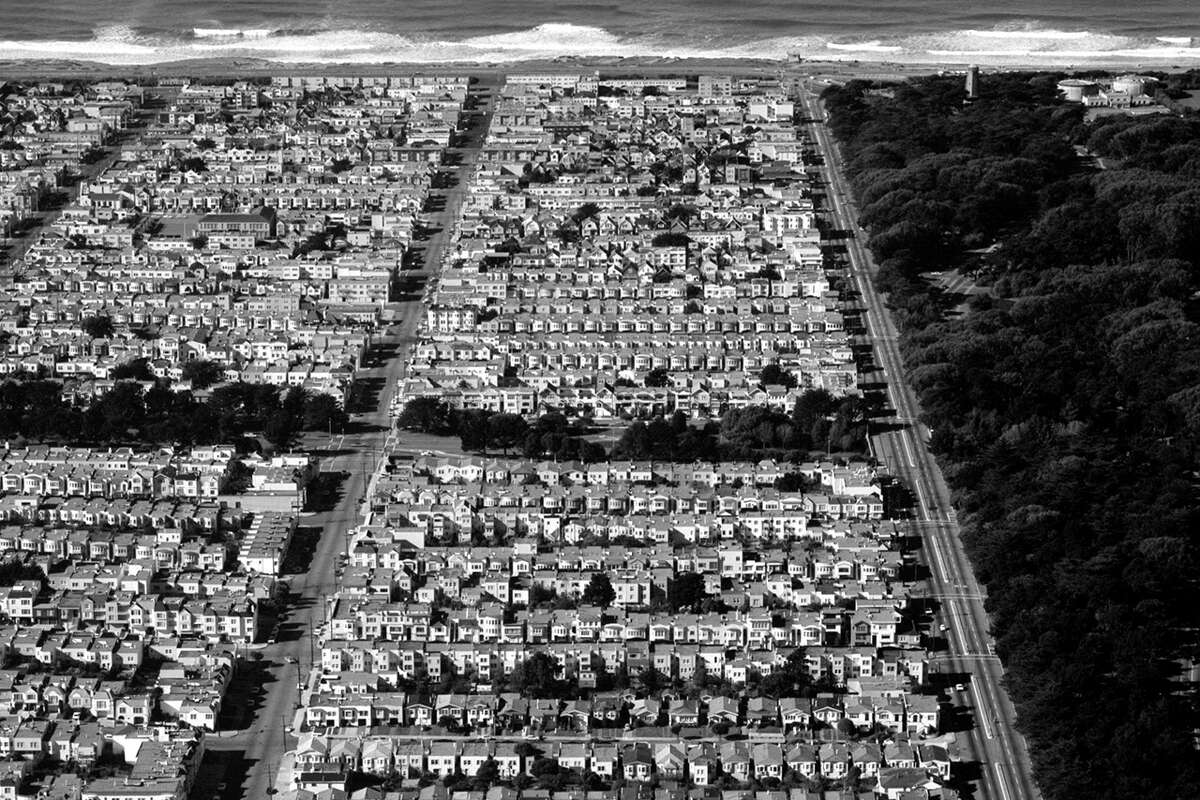After one of the longest, most prolific careers of any 20th century photographer, Fred Lyon has died. He was 97.
Accomplished in an array of genres — from fashion, food and wine to sports, travel, advertising and architecture — Lyon, who died of lung cancer at his Cow Hollow home on Monday, Aug. 22, was often referred to as San Francisco’s Brassai.
“He was of an era that doesn’t exist anymore,” says gallerist Peter Fetterman.
While Lyon is compared to great street photographers and photojournalists such as Brassai, Henri Cartier-Bresson and Alfred Eisenstaedt, Fetterman says Lyon’s personality and optimism was more like actor Cary Grant: “He was just the most charming, affable, full of life, positive, gracious human being that I’ve ever met.”

Telegraph Hill from Russian Hill, 1953
© The Estate of Fred Lyon / Courtesy Peter Fetterman Gallery
Peter Fetterman Gallery in Santa Monica represents Lyon, and when the two men met 20 years ago, Fetterman says he was bowled over by Lyon’s work.“I was so impressed by it, and so amazed that I hadn’t connected with him before. He was a kind of undiscovered, living treasure.”
The serendipitous style of many of Lyon’s successes is especially evident in the way a recent project evolved, when business author and strategist Philip Meza approached Lyon about writing a biography. Even before a proposal was penned or a publisher was lined up, Lyon agreed to be interviewed. He was 95 years old and didn’t want to wait, says Meza, who, twice a week for six months in 2020, walked from his home in the Marina to Lyon’s studio. Meza would stay for two hours or more listening to Lyon describe a dizzying calendar of assignments, adventures in California and abroad, working for prominent outlets and demanding editors.
“He worked for all the major publications of the day and they trusted him. If there was anything interesting going on in the West, Fred was the first call they made,” Fetterman says. “They knew he would deliver something really special, often at short notice.”
Lyon’s job log was full of appointments to shoot upscale apartments, prominent designers (Frances Elkins, Michael Taylor, John Dickinson to name a few), South Bay mansions, Wine Country resorts (Sonoma Mission Inn and Auberge du Soleil) and local landmarks like the Frank Lloyd Wright store on Maiden Lane. His roster of glossy magazines included Holiday, House & Garden, Glamour, Vogue, Fortune, Time and Architectural Digest. Two Lyon photographs were part of the 2018-2019 San Francisco Museum of Modern Art exhibition “The Sea Ranch: Architecture, Environment, Idealism.” He’s also exhibited at the Legion of Honor and the Art Institute of Chicago.

Fred Lyon often shot interiors of upscale homes for the likes of publications such as House & Garden, Glamour, Vogue and Architectural Digest.
© Fred Lyon
Rizzoli Publications chose the interior design chapter of Lyon’s life for Meza’s “Inventing the California Look: Through the Lens of Fred Lyon,” a gorgeous coffee-table book that came out in April. Meza says collaborating with Lyon was like “a master class in living life well,” and that the gifted photographer and writer was also a good talker. (At San Francisco’s Fall Show, Meza is scheduled to discuss the Rizzoli book and California design past and present, followed by a tribute to Lyon, on Oct. 14.)
Another spring release featuring Lyon’s images is Taschen’s super-thick, meticulously curated history, “San Francisco: Portrait of a City,” by Reuel Golden and Richie Unterberger. The Leica Store on Bush Street, near San Francisco’s Union Square, has copies for sale recently signed by Lyon; gallery director Alex Ramos says $1,500 art editions (which include two Lyon prints) are also being shipped.

Powell and Market Street with Woolworth’s, San Francisco, 1952
© The Estate of Fred Lyon / Courtesy Peter Fetterman Gallery

Seagull over Golden Gate Bridge, c. 1950’s
© The Estate of Fred Lyon / Courtesy Peter Fetterman Gallery
From left, “Powell and Market Street with Woolworth’s, San Francisco, 1952” and “Seagull over Golden Gate Bridge, c. 1950’s” (© The Estate Of Fred Lyon / Courtesy Peter Fetterman Gallery)
Lyon was born Sept. 27, 1924, in San Francisco. His family later moved to Burlingame, where he attended high school.
He focused on photography as a teenager, enrolling at the Los Angeles Art Center. One summer he studied with Ansel Adams, coming to the realization his own path would differ from that of the landscape photographer.
Career plans were partially interrupted when he enlisted in the U.S. Navy after the Pearl Harbor attack. As a military photographer in Washington, D.C., Lyon witnessed Harry S. Truman’s first day in the Oval Office following the death of President Franklin D. Roosevelt.
New York City was next. Self-educated in fashion photography, Lyon was soon shooting models and catwalks, after-hours and quotidian street scenes. He signed on with agent Charles Rado, who, according to Meza, wisely advised him to “go out and take photographs for yourself, do something to satisfy yourself.”
Fetterman says Lyon’s talent is the humanistic way he captured those personal moments. “That’s who he was. He cared about people, he liked people, he enjoyed being around people. He wasn’t a kind of angst-ridden, tortured soul.”
Eventually, Lyon moved back to his beloved Bay Area. His first wife, the model Anne Murray, is front and center in some of Lyon’s most sought-after images; she died in 1989. He loved regaling journalists and friends with the story behind the famous photograph, “Foggy Night at Land’s End,” featuring Murray and their Sausalito landlord.

Foggy Night at Land’s End, San Francisco, 1953
© The Estate of Fred Lyon / Courtesy Peter Fetterman Gallery
In 2003, Lyon married interior designer Penelope Rozis, who says they “became like one person, a real team,” adding that their San Francisco home was highly conducive to Lyon’s hard-driving days — four hours of work mornings in the studio, upstairs for lunch, then four more hours in the studio.
Known for moody shots of fog-bound Golden Gate Bridge, Coit Tower, Nob Hill hotels and cityscapes, Lyon was so adamant about escaping San Francisco’s cool, foggy summers that he bought property in Napa Valley in the early 1970s, eventually building a house, planting a vineyard and indulging his obsession with winemaking. “He had a romance with grapes,” says Rozis.

Fred Lyon with his wife Penelope Rozi.
Photo courtesy of Penelope Rozis
Princeton Architectural Press published “Vineyards” in 2019, in which Lyon documented vintners, aerial views, crushes, tastings and agricultural workers both in California and around the globe. With humor, Lyon compared his foray into winemaking in “Vineyards” as like “The Marx Brothers Make Wine,” involving a “scavenged washing machine that I used as a centrifuge on its spin cycle. It worked, but the word got out, and we took such a ribbing that we acquired a real basket press for the next harvest.” Lyon’s “San Francisco: Portrait of a City 1940-1960” (2014) and “San Francisco Noir” (2017) were also Princeton Architectural Press releases.

Mark Hopkins Hotel, San Francisco, CA, 1950
© The Estate of Fred Lyon / Courtesy Peter Fetterman Gallery

San Francisco, Sunset District, Ocean at Top, c. 1950’s
© The Estate of Fred Lyon / Courtesy Peter Fetterman Gallery
From left, “Mark Hopkins Hotel, San Francisco, CA, 1950” and “San Francisco, Sunset District, Ocean at Top, c. 1950’s” (© The Estate Of Fred Lyon / Courtesy Peter Fetterman Gallery)
“His DNA was in San Francisco and his spirit was there,” Fetterman says. “And I think he wanted to preserve the spirit of a city that I think he knew deep down in his heart was going to change, as all cities change, through development, real estate. … Like Noel Coward, it’s the end of an era, and that’s why I think people are attracted to the work. Because it evokes so many great memories.”
With no intention of retiring, Lyon was in the midst of putting together beloved Parisian pictures. Even though editors told him there were already too many books on Paris, Rozis says she knows her husband would have persevered. He was also working on a collection of photographs of the West when he died. Besides his wife, Lyon is survived by sons Michael and Gordon. Service plans are pending.

Fred Lyon in his San Francisco studio, in 2016.
Photo by Lisa Amand
Journalist Lisa Amand (@Imnofoodie on Twitter), currently based in New York City, has lived in San Francisco and Sonoma Valley, and feels at home on both East and West Coast.

